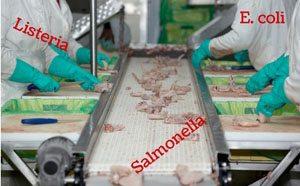With the implementation of the Food Safety Modernization Act (FSMA), as well as the recently released FDA Guidance on controlling Listeria monocytogenes in RTE foods, it is more important than ever to have a carefully designed, robust Environmental Monitoring (EM) program in your food manufacturing plant. Effective design of your EM program is essential to both minimizing the risk of contamination and meeting regulatory requirements. A common method for designing an EM program is the Zone Concept, whereby you divide your facility into four zones and determine the sampling and testing strategy for each zone individually. This strategy includes frequency of sampling, analytes, sample volume and significance of results.
Zone 1 includes areas that may come in direct contact with your products during manufacturing such as fillers, containers, racks and slicers. Zone 2 encompasses areas directly adjacent to Zone 1, which therefore present the risk of transferring contamination into Zone 1 and possibly direct contact with products. Zone 2 sites include external areas of packaging equipment, control panels, switches and refrigeration units. Zone 3 includes non-product contact sites adjacent to Zone 2, that are still within the protected area of the facility, including floors, walls, ceilings, floor mats, drains, brooms/mops/squeegees, phones, forklifts, drains and wheels. Areas outside the processing areas such as hallways, loading docks, locker rooms, and employee break areas constitute Zone 4. Foot traffic within the facility should be considered when determining the zones, and how they will be monitored.
Once the facility has been divided into four zones, the next step is determining the specifications of the EM program, such as what tests to perform. A common practice is to test for indicator organisms (Plate Count, Coliform, etc.) in Zone 1 and for pathogens (Listeria, Salmonella, etc.) in Zones 2-4. However, this can be adjusted if the product(s) involved has a history or a tendency to be contaminated with a pathogen. Occasionally changing the sampling parameters and checking for pathogens in Zone 1 and indicators in Zones 2-4 can also provide usable data. Many times if indicator organism counts rise suddenly, it is wise to check for pathogens in the affected area, regardless of Zone designation. If products containing any of the eight primary food allergens (milk, eggs, fish, crustacean shellfish, tree nuts, peanuts, wheat (gluten) and soy) are being produced, sampling and testing for residual levels of these allergens should also be part of the EM program to avoid cross-contamination with allergen-free products.
Another determination to make is scheduling of sampling. Location and frequency of sampling should be determined by the risk levels inherent to the product type and production process. Areas that would be tested at higher frequency include those with high traffic, water use, or history of pathogen detection. Also, areas where raw materials are handled and stored would be subject to increased frequency of monitoring. While Zone 1 sampling is usually performed pre-operationally, varying the times and shifts monitored within surrounding zones will allow for a broad snapshot of your facility throughout all stages and shifts of production.
Financial factors often affect the frequency of EM sampling, as obviously the more often testing is performed the higher the costs of the EM program. Creating a rotation of selected locations will allow for a comprehensive monitoring plan while keeping costs in check. Each facility is different and poses different risks of contamination, so a walk-through audit with a food safety expert, identifying potential trouble spots is vital to designing your EM program. Sampling can be performed utilizing a variety of implements including swabs for small spaces and crevices, sponges for larger areas and telescopic devices with swabs and/or sponges attached for hard to reach or elevated areas. Many EM programs involve a combination of these sampling tools.
Once baseline data is collected, establishing action levels and appropriate responses to your EM test results will make for a seamless process if an out of specification result occurs. For example, a positive Listeria result in Zone 3 might trigger an immediate re-sanitization of Zones 1 & 2 to reduce the chances contamination has transferred between Zones. Implementing an emergency, wide range sampling of Zones 1 & 2 may also be in order in this example. If possible, holding product until the results of the emergency sampling are available may be prudent. This is where a rapid testing solution such as PCR may be advisable, providing results as quickly as 24-hours and therefore minimizing hold time for release of your product(s).
Environmental monitoring should be part of your food safety due diligence process to determine potential sources of contamination before compromising a food product. Several variables must be considered to design a program that provides the most effective and meaningful measurements for your particular facility and product type(s) while helping to prevent a costly recall.





